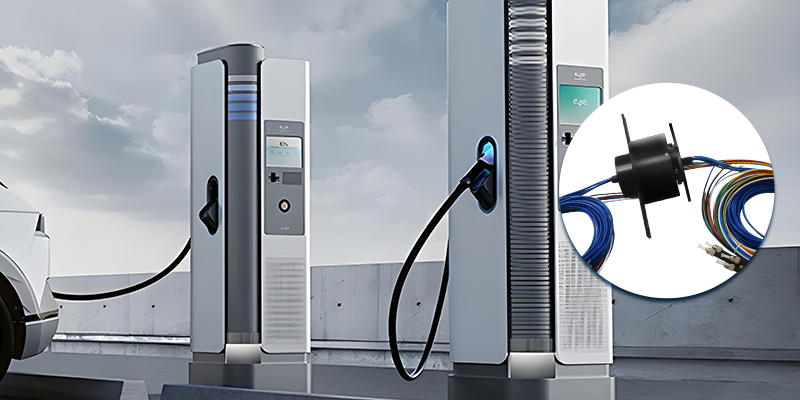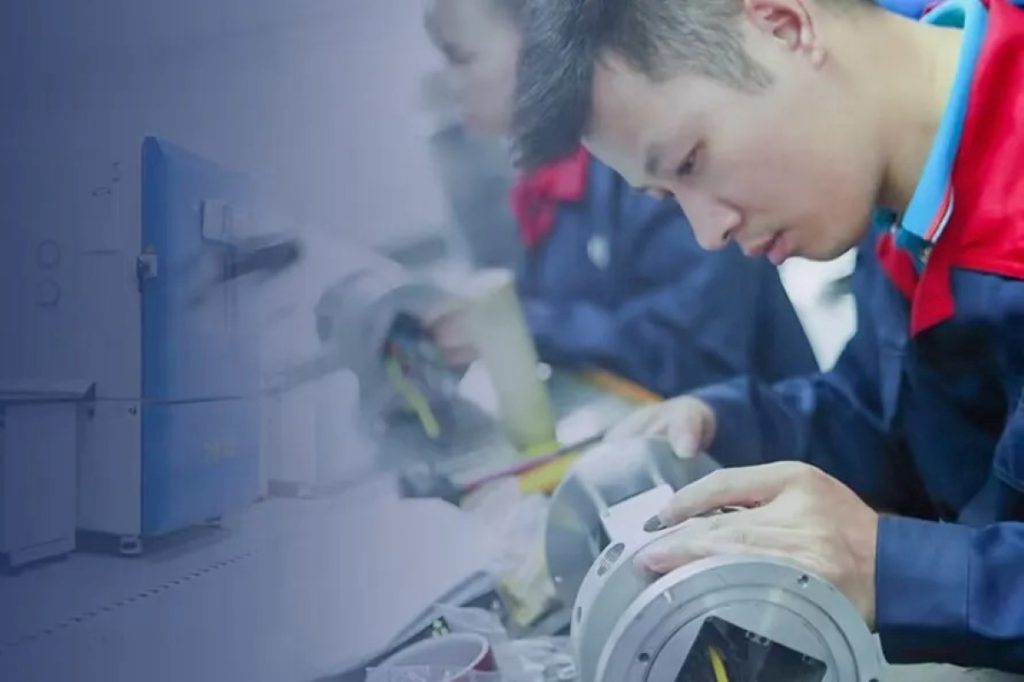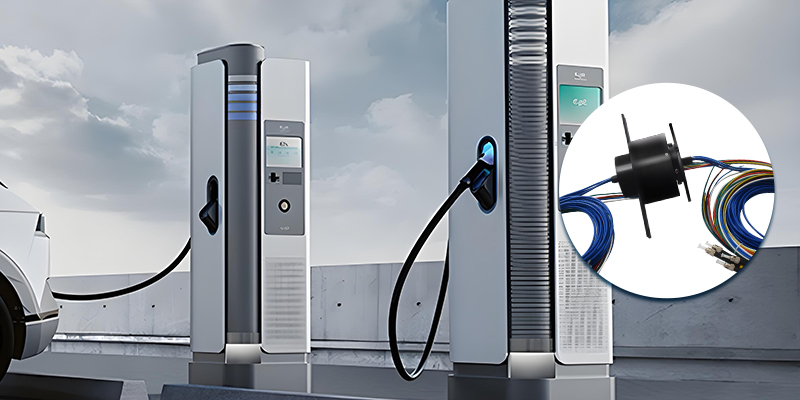Welcome to a comprehensive review encompassing the fundamental role of slip rings in the operation of charging piles. This article aims to delve deep into the interaction between these two key components, unearthing the intricacies of their relationship. We will walk you through the complexities of a system that may seem straightforward at first glance.
Charging piles, often compared to fuel pumps for petrol and diesel vehicles, form the backbone of the expanding electronic vehicle universe. They serve the mission-critical purpose of recharging electric vehicles, which fundamentally contributes to our sustainable and greener future. However, the mechanics behind a charging pile include intricate hardware and software details that enable efficient and sleek operations.
Enabling the rotary transmission of electric power within these charging stations are slip rings. An unassuming yet pivotal component, slipping rings play a substantial role in transmitting power and data seamlessly between stationary and rotating parts. Their role can be compared to a conduit enabling the smooth flow of power from the source to the demanding electric vehicles. The importance of slip rings becomes even more pronounced considering the global move towards electronic vehicles to combat emissions.
As we embark on this informative journey, we will delve into the details of slip rings, address user concerns about their performance and longevity, and discuss the innovative technological advancements aimed at enhancing their effectiveness. We will shine a light on the foreseeable future of slip ring application in charging piles and address some frequently asked questions in the space.
Get ready for a deeper understanding of the role and undoubtedly significance of slip rings in charging piles, as their interconnected relationship catalyzes the progression of an efficient, sustainable, electric future.
The Role of Slip Rings Application in Charging Piles
To fully appreciate the role of slip rings in charging piles, it’s important first to understand how charging piles function. These devices, akin to fuel stations for traditional vehicles, are essentially power supply units designed to recharge the batteries of electric vehicles. They constitute a set of electronic, electrical, mechanical, and communication systems, working in harmony to provide safe and efficient charging.
At the core of the homogenous functioning of these systems in a charging pile, lies an elegant solution – the slip ring. Also known as rotary electrical interfaces, rotating electrical connectors, collectors, or swivels, slip rings play the unsung hero by performing the crucial task of transmitting electrical power and data from a stationary part of the charging pile to its rotating components.
In essence, slip rings allow the unobstructed flow of power between different parts of the charging pile, irrespective of their motion. They are designed to ensure that electrical connectivity is maintained, be it for power or data signals, while parts of the system rotate or move relative to each other. Thanks to their unique design that combats the challenges of power continuity amidst constant motion, slip rings act as effective facilitators of power transmission in charging piles.
The inclusion of slip rings in charging piles provides several key benefits. For one, they allow for seamless energy transfer, reducing potential energy loss that would otherwise occur due to rotating components. This results in more efficient charging times. Additionally, slip rings contribute to the longevity and reduced maintenance of charging piles, by limiting wear and tear from sliding of contact surfaces. Finally, they enhance the overall reliability of the charging pile, ensuring the consistent power supply necessary for optimal operations.
As we continue to venture into the era of renewable and cleaner energy, components like slip rings will continue to shape our technological landscape, enabling innovation to thrive and encouraging us to reimagine what’s possible.

User Concerns About Slip Rings Application in Charging Piles
The shift towards electric vehicles denotes a significant technological shift, with components such as slip rings at the intersection of these changes. While the advantages are undeniable, users often raise valid concerns regarding their performance and durability in the context of charging piles.
Performance is often depicted by three key parameters: efficiency, reliability, and consistency. Users expect slip rings to facilitate efficient power and data transmission, reducing charging times and enhancing customer experience. Equally significant is the demand for reliability – the ability of slip rings to operate as expected under specified conditions and yield predictable results every time. Consistency, the ability to deliver predictable performance across diverse circumstances, further forms a cornerstone of user expectation from slip rings.
Durability factors into user concerns too, focusing on longevity, failure rate, and maintenanceneeds. Users anticipate slip rings that can withstand the test of time and repeated usage, providing a hassle-free experience. The failure rate of slip rings directly translates to the downtime of charging piles – a major concern for charging station operators. Therefore, a low failure rate is fundamental for operational efficiency. Additionally, slip rings that require minimal maintenance can significantly reduce operational costs and downtime, boosting overall user satisfaction.
The importance of data and power transmission cannot be underestimated either. Users envision a system that ensures quick, accurate, and noiseless transmission. Speed directly affects the charging time, a critical factor for EV owners. Accuracy of transmission is vital to maintain the integrity of the charging process. Lastly, a noiseless operation ensures a smooth user experience, eliminating any potential issues associated with electromagnetic interference.
Finally, operational issues related to the installation, integration, and replacement of slip rings often weigh on users’ minds. A complex integration process could lead to increased costs and extended setup times. Similarly, significant difficulties in the replacement of slip rings could lead to extended downtime, directly affecting user experience and operational efficiency.
Addressing these concerns is crucial in ensuring the seamless adoption and enduring success of charging piles in our quest for a cleaner, greener future.

Slip Rings Application in Charging Piles: Technological Advancements
Keeping user concerns as a focal point, today’s technological advancements are reshaping the role of slip rings in charging piles, effectively addressing many of these apprehensions.
One such advancement is the use of advanced materials in the construction of slip rings. The use of high-performance alloys, improved conductive materials, and optimized brush designs contribute to the enhanced durability and performance of slip rings. These improvements not only foster greater longevity of the components but also advance their efficiency, leading to faster, more reliable power transmission. From the perspective of durability, this also translates into less wear and tear, effectively reducing the failure rate and extending the life span of charging piles.
The advent of smart technologies, including the Internet of Things (IoT) and real-time monitoring systems, provides a substantial boon in the functionality of slip rings. These technologies enable predictive maintenance, alerting operators of potential issues before they escalate into major faults. This predictive approach could significantly reduce the downtime of charging piles and improve their overall reliability. Furthermore, these technologies contribute to a more refined, user-centric experience by enabling data-driven insights and customized charging solutions.
Design innovations also play a pivotal role in enhancing the performance and adoption of slip rings in charging piles. These breakthroughs address inherent challenges associated with the installation, integration, and replacement of slip rings. For example, modular and flexible designs of slip rings simplify the installation process and make replacement or maintenance jobs more time and cost-efficient. Additionally, innovations like contactless slip rings (via magnetic or inductive methods) are pushing the envelope for operational efficiency and power transmission capabilities.
In essence, technological advancements sit at the crux of addressing user concerns, helping to cement the role of slip rings as an integral part of the charging pile infrastructure. As we continue to evolve and innovate, these improvements will drive forward the trajectory of the EV charging ecosystem.
The Future of Slip Rings Application in Charging Piles
As we look forward to the future of charging piles, the role of slip rings becomes even more defining. Their evolution, dictated by emerging trends and ongoing innovation, will be crucial in defining and shaping the advancements in this space.
Several emerging trends are shaping up in the slip ring market, promising new and enhanced solutions. Some key advancements include the development of fiber-optic rotary joints (FORJs) for higher data transmission rates, the use of optoelectronics for high-speed data transfer, and contactless slip rings for extended life spans and improved efficiency. These ongoing evolutions are set to significantly improve the performance of slip rings in charging piles.
Speculation about the future role of slip rings is ripe among industry experts. Some predict the role of slip rings in enabling the development of more efficient and powerful charging piles. Imagine rapid charging stations that can fully charge electric vehicles in a matter of minutes – such stations would require slip rings capable of handling immense power loads without losing efficiency or risking damage. With ongoing advancements in material science and electrical engineering, such possibilities are closer to reality than ever before.
The exploration of potential benefits for end-users revolves mainly around increased charging speeds, lower maintenance requirements, and the potential for wireless charging technology. More robust and efficient slip rings could significantly increase the charging velocity, enhancing the user experience. Technological advancements that reduce maintenance requirements or extend lifespan would translate into less downtime and greater convenience. Further, one of the grand visions of the future is wireless charging for electric vehicles. Creating wireless charging infrastructure would involve contactless slip rings, an innovation that could revolutionize the way we perceive vehicle charging today.
The future of slip rings in charging piles illuminates a trajectory of progress, with greater efficiency, reliability, and experience as core benefits for end users. As we move towards a future fueled by renewable energy, these components play a major role in creating a sustainable yet efficient energy infrastructure.
Conclusion
Given their crucial role, the importance of slip rings in recharging piles cannot be exaggerated. Despite the challenges related to durability and efficiency, advancements in technology are continuously addressing these issues. As research and development continue, future applications could reveal even more practical solutions, contributing to a greener and cleaner EV infrastructure.
FAQs about Slip Rings Application in Charging Piles
The complexity and novelty of electric vehicle infrastructure, particularly charging piles, often lead to a host of queries from concerned users. To address this, we’ve compiled some frequently asked questions that touch on key areas like efficiency, durability, maintenance, and technological advancements in the context of slip rings used in charging piles.
Q: How efficient are slip rings in transmitting power and data in charging piles?
A: Slip rings are quite efficient, facilitating seamless power and data transfer between the stationary and rotating components of a charging pile. Their exact efficiency can vary depending on the design, materials used, and specific implementation. Ongoing research and development are driving innovations aiming to boost this efficiency further.
Q: What is the life expectancy of slip rings in charging piles? Are they durable?
A: Slip ring durability is determined by various factors, including the quality of the materials used, the design, and the environmental conditions under which they operate. With proper maintenance, quality slip rings can tend to have a long service life. The introduction of advanced materials and design innovations is enhancing the durability of slip rings.
Q: Do slip rings require a lot of maintenance?
A: In a general sense, slip rings may require periodic maintenance to ensure their smooth operation, primarily to prevent wear from affecting performance. However, improvements like the use of advanced materials and non-contact technology are reducing the frequency and complexity of this maintenance.
Q: Are there any recent technological advancements that are improving the functionality of slip rings in charging piles?
A: Yes, there are numerous technological advancements shaping the future of slip rings. These range from the use of advanced, wear-resistant materials to smart technologies, such as IoT-based real-time monitoring systems for predictive maintenance. Further, design innovations like modular concepts and contactless slip rings are revolutionizing the operational efficiency and integration simplicity of slip rings.
See What We Can Do

